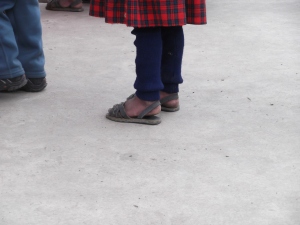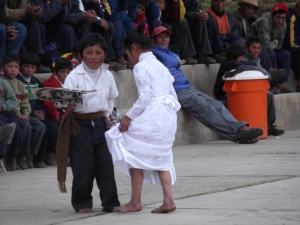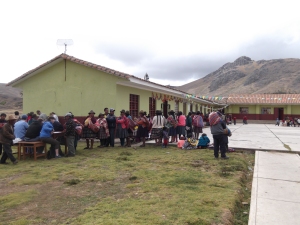This was going to be a special bus trip. At breakfast we were told that we were going high up into the mountains on the east side of the valley (opposite to Cusco) and it would be cold. Everyone rushed back to their rooms to grab an extra layer of clothing. We even grabbed our wool caps and gloves just in case.
As usual we picked up Dr. Morales and a couple of Quechua translators at Pisac. They told us to keep our cameras ready as the views would be terrific; and they were right!  After about 15 minutes, our bus went off the beaten path and took what looked like a small trail (was actually much wider but we did not appreciate that right away) on the edge of a huge mountain.
After about 15 minutes, our bus went off the beaten path and took what looked like a small trail (was actually much wider but we did not appreciate that right away) on the edge of a huge mountain.  The valley on the right and the huge mountains around us made for an amazing spectacle. The driver handled the numerous switchbacks with aplomb but we would all subconsciously lean to the left at every turn. When someone leaned over to the right to get a photo of the valley, we would shout to tell him to get back in his seat! A decision was made that we would wind up our visit by 4.00 PM so we did not have to navigate these roads at dusk.
The valley on the right and the huge mountains around us made for an amazing spectacle. The driver handled the numerous switchbacks with aplomb but we would all subconsciously lean to the left at every turn. When someone leaned over to the right to get a photo of the valley, we would shout to tell him to get back in his seat! A decision was made that we would wind up our visit by 4.00 PM so we did not have to navigate these roads at dusk.
We reached our destination which we called Chew On Tire (actually spelled as Chawayantire) located in a large bowl shaped valley much like Cusco with terraced farming and green pastures. The school consisted of a train of rooms arranged around a stone flagged play area.  There was a big celebration planned that day to commemorate the school anniversary and also as a welcome reception for us.
There was a big celebration planned that day to commemorate the school anniversary and also as a welcome reception for us.  The school kids were dressed in traditional clothes and did a number of folk dances.
The school kids were dressed in traditional clothes and did a number of folk dances.  Some of these were done in bare feet or open sandals on the cold stone surface.
Some of these were done in bare feet or open sandals on the cold stone surface.  Sabrina commented on how glad she was we were going to distribute shoes to the school kids. Behind the school we could see cows grazing
Sabrina commented on how glad she was we were going to distribute shoes to the school kids. Behind the school we could see cows grazing
and roaming freely. The facilities were excellent and all the teams were able to work indoors. This was good because there were a couple of showers that would really have put a damper on the proceedings on that very cold day.
We saw quite a few patients. I was surprised to see that no one had hypertension (blood pressures were in the 100/50 range for a lot of adults!). No one had symptoms suggestive of diabetes. We used urine dip sticks to check for sugar that day as we had left the strips that go with the glucose machines back at the hotel.
One younger adult came in with a strange complaint. He had stepped on a nail a few months back and now thought his entire leg on that side was numb or dead. The exam was completely normal and his symptoms did not fit any medical diagnosis. We wondered if we were losing something in translation (he did speak Spanish which my medical student was fluent in) or whether this was a cultural issue. We could sense he was unsatisfied when we could not find an answer to his problem. Another patient we did pick up a distal neuropathy in the stocking distribution. Her urine glucose was negative and we guessed she might have B12 deficiency possibly from Giardiasis. We treated her empirically with albendezole which we had brought with us.
 The lines were long and we had planned to leave by 4.00 PM. This meant we had to start winding up by 3.00 – packing our supplies, carrying them back to the bus and loading them on the room rack, saying good byes etc. Some of the patients after seeing the medical team had made it to the ophthalmology and pharmacy area and had been waiting there for a long time. No one wanted to tell them they could not be seen. On top of it the local folks had cooked soup for us and it would be very rude not to at least taste it before leaving. No one wanted to sit and drink soup while there were patients waiting to be seen. The problem was solved by splitting up. Some of us made several trips back and forth loading up the supplies. The ophthalmology team continued seeing patients till they were all seen and a small group had soup with the local folks to make sure they did not feel offended. We were able to leave only about 30 minutes after 4.00 and there was still sufficient light to drive safely. I will remember the very strong feelings the students expressed about making sure every one was seen and no one was turned away!
The lines were long and we had planned to leave by 4.00 PM. This meant we had to start winding up by 3.00 – packing our supplies, carrying them back to the bus and loading them on the room rack, saying good byes etc. Some of the patients after seeing the medical team had made it to the ophthalmology and pharmacy area and had been waiting there for a long time. No one wanted to tell them they could not be seen. On top of it the local folks had cooked soup for us and it would be very rude not to at least taste it before leaving. No one wanted to sit and drink soup while there were patients waiting to be seen. The problem was solved by splitting up. Some of us made several trips back and forth loading up the supplies. The ophthalmology team continued seeing patients till they were all seen and a small group had soup with the local folks to make sure they did not feel offended. We were able to leave only about 30 minutes after 4.00 and there was still sufficient light to drive safely. I will remember the very strong feelings the students expressed about making sure every one was seen and no one was turned away!
The true essence of professionalism is putting the patient interest before your own. We design curricula for teaching professionalism. I am beginning to wonder if it is the doctors who need this curricula more than the students? The students I worked with had these qualities already; when we put them in charge and removed the layers of bureaucracy and restrictions that are part of working in the US, they do the right thing and without having to be taught! “They don’t need no education”
When the initial decision was being discussed to wind up while there were still patients in lines, our daughter had tears in her eyes. On the way back our daughter kept asking, “we saw everyone right?” She felt so proud that she was able to help so many people, some her own age and some much older and younger. What happens to these sentiments as students make their way through the health care system? They get wrapped up in the world of RVUs, the E/M codes, the CPT codes, lengths of stay and readmissions, tenure tracks and research papers, fighting over first authorships, using relative risk reductions (instead of absolute risk reductions and numbers needed to treat) to try and combat publication bias… Then we send them to curricula to re learn professionalism and how to improve patient satisfaction! The lyrics of Pink Floyd were never truer!
Out in the remote wilderness of a mountain top in the Andes, I wondered what the US healthcare system would look like if we wiped the slate clean and allowed these dedicated, self motivated, energetic and bright young minds to redesign it. They have no hidden agenda, no prior investments in a certain specialty, no huge fixed cost hospital buildings to maintain, no million dollar CEO salaries to support. That day I had no doubt that it would be a better place we would go to! Maybe it was the high altitude, or too much coca tea or maybe, just maybe I briefly glimpsed a vision of truth. Is this why people sit on mountain tops to gain wisdom?


Field experiences bring out the altruistic spirit in people. When we see those less fortunate, and we are on a mission trip to help them, we are inspired. Medical mission or faith based mission trips are similar in that we go to help others and a dividend is provided to us. We are refreshed.
Suzanne thanks for the comment. Agree with the sentiments. Truly a rejuvenating experience.
Neil,
This is a great adventure with multiple life lessons. Glad to see altruism is alive and well in medicine. We need to ensure this in the US which is often too focused on financial and administrative aspects as you say.
John,
Thanks for the comment. Sometimes one has to get away from it all to gain a true perspective. We need a system that allows physicians to do what they do well and what they want to do without squeezing all the joy out of the process. Have a great father’s day!